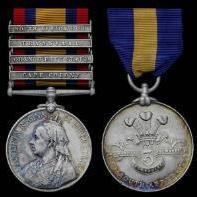-
Posts
1,770 -
Joined
-
Last visited
-
Days Won
4
Content Type
Profiles
Forums
Blogs
Gallery
Events
Store
Posts posted by azyeoman
-
-
Further proof that you should stick with reliable sellers like myself


Well, you're right. I know you're not tooting your own horn, but you are right. I've only got a couple of items from you, but they are just as you described and not leaving my collection!
Cheers,
 0
0 -
Correct. The Japanese like items in excellent condition. They do not have to be pristine, however they do need to have complete original ribbons and no enamel damage. Also I have seen boxed examples regualrly go for more than doubel the price of the unboxed medal, effectively giving the case the same inherent value as the medal itself !
Thanks Paul. I appreciate the insight. Do you think there are differences in collecting when it comes to other cultures;i.e., Germans, Russians, etc.? I've only just started collecting Japanese medals and find the bars most attractive. I've always found that to be the same with German medals too; perhaps it's due to the fact that they're unnamed for the most part and so I looik to find some sort of tangible connection with the original recipient. Having collected British medals for over 30 years, it's easy to make that connection as they're named (for the most part) and so easy to research. As someone who has obviously traveled extensively and has an etensively knowledge of medal collecting, it would be an interesting turn for this strand to know what people have recognized as cultural collecting traits, if any. Perhaps there are collectors elsewhere who only want relics as opposed to pristine examples or singles as oppossed to groups. The "menu" for collectors is quite long a varied, but I suspect there may be generalizations that are made vis-a-vis cultures and/or nationalities.
PS: After all is said and done, I've paid more for a boxed or cased St. Helene than I would have for a couple of St. Helenes by themselves so know the feeling.
 0
0 -
Hello,
the war-aid cross counts as a decoration awarded for war-service. So it was worn before any civil decoration like the RAO.
Best wishes and merry christmas
Markus
Do you know why the person would have had the War Aid Cross mounted with the reverse forward. I've seen this a few times and have always wondered why? Thanks in advance for any help in understanding this. All the best and Happy New Year!
 0
0 -
I would describe it as "Very Fine with ribbon damage and toning". Japanese items are one of the countries where you want to avoid changing ribbons (unlike British medals where that is less of an issue). A piece in this condition would never sell in Japan unless it was for about 25% of the normal market price.
Would it not sell in Japan because they prefer only pristine items? Personally, I like items that were worn and/or used by the soldier, sailor or airman. It's a matter of taste, but an medal or insignia that is was unissued and sat on a shelf is less interesting to me than one that has that "was-there" look about it. On the other hand, I'll be the first to admit that I always look at condtion and rarity in conjunction to the history. In short, do you think there are "cultural" differences in collecting militaria? In general, do the Japanese only want perfect single medals that are cased? Have never been fortunate enough to visit Japan, it would be interesting to know what you think. Cheers and happy New Year to everyone!
 0
0 -
Exactly what I was attempting to see!
It's definitely not the handiwork of the infamous Austrian!
The bar looks good!
Would it be possible for you to post a list of this man's "traits" along with photos of his work so that us punters can be better armed in the mine field of parade mounted bars. Tom has helped to eductate me enormously and has been a consumate professional educator and collector for my fledgling collection of WWI TR parade mounted bars. (Yes, I was stung but fortunately all of the dealers refunded my money to the last penny!) At any rate, I'm ignorant when it comes to Imperial bars and would appreciate any and all info you could share. Thanks in advance and happy holidays to all!
 0
0 -
Very nice and interesting. Perhaps you could write something up for the Orders and Medals Society of America or the Orders and Medals Research Society. I'm sure it would be greatly appreciated. Thanks for sharing.
0 -
I was there when the Saudis adopted the chocolate-chip style and it was during Gulf War I. Prior to that, they wore a grey colored one. I left in '95 and they had switched over to a new one without the chocolate chips. Although the cut was the same, the camo resembled something between the US and the UK's camo colors. FYI, the French had their own style, which was different too.
Hope this helps.
0 -
Here are some photos of the badge and one of the accompanying medals.
Hi Jacques,
I tried posting three photos and they don't seem to be visible. I haven't a clue as to why not. Sorry, I'll keep trying.
0 -
Hi,
could you post pictures of obverse and reverse of that badge ?
jacques
Here are some photos of the badge and one of the accompanying medals.
0 -
When I acquired an Italian group for Spanish Civil War Service, there was a "Fritz the Cat" enamel lapel badge that accompanied the group. I have been unsucessful in finding out which unit used this emblem and would be grateful if anyone could help.
Best regards and happy holidays!
 0
0 -
...while you are waiting for Paul's scans...here are mine:
Here is the Field Commanders Badge from my collection (should be a good one :-)
Thank you very much. This makes it clear as to what everyone should look for. It certainly seems that the four "lugs" are the most obvious indication of a good badge as the reproductions don't have those. Thank again very much.
0 -
Originals are scarce. I will post pictures over the weekend of an original company grade commander's badge. They still make copies of them in Japan, most of which are marked as copies on the reverse. Those that are not will be of different style to the originals. I have no idea on the number of makers but given the scarcity of the badge I do not think it would have been substantial.
Thank you Paul. I look forward to seeing the photos. I really appreciate it very much.
0 -
Are commander's badges unusual to find and were there different makers for the different types? I've read that they are still being produced in Japan. Does anyone know how can you tell and origianal one from a newly made one? Thank you.
0 -
Thank you very much. That clarifies it. I sincerely appreciate your help.
0 -
Hello,
Was everyone who was awarded the '14-'15 or the '14 -'20 War Medal entitled to the WWI Victory Medal? I've seen medal bars that lack the Victory but have the War Medal.
Any thoughts would be greatly appreciated.
Cheers
0




Rheinland-Orden & Marko Karg?
in Germany: Imperial: The Orders, Decorations and Medals of The Imperial German States
Posted
Has anyone bought anything from Marko Karg of Rheinland-Orden?